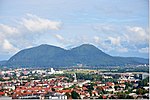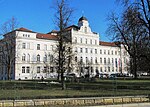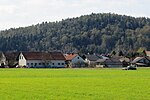Vižmarje
Šentvid District

Vižmarje (pronounced [ˈʋiːʒmaɾjɛ], German: Wischmarje) is a formerly independent settlement in the northern part of the capital Ljubljana in central Slovenia. It is part of the traditional region of Upper Carniola and is now included with the rest of the municipality in the Central Slovenia Statistical Region. It is located in the northwestern part of the city and belongs to the Šentvid District.
Excerpt from the Wikipedia article Vižmarje (License: CC BY-SA 3.0, Authors, Images).Vižmarje
Aleševa ulica, Ljubljana Gunclje
Geographical coordinates (GPS) Address Nearby Places Show on map
Geographical coordinates (GPS)
| Latitude | Longitude |
|---|---|
| N 46.112161111111 ° | E 14.460169444444 ° |
Address
Aleševa ulica
Aleševa ulica
1210 Ljubljana, Gunclje
Slovenia
Open on Google Maps









